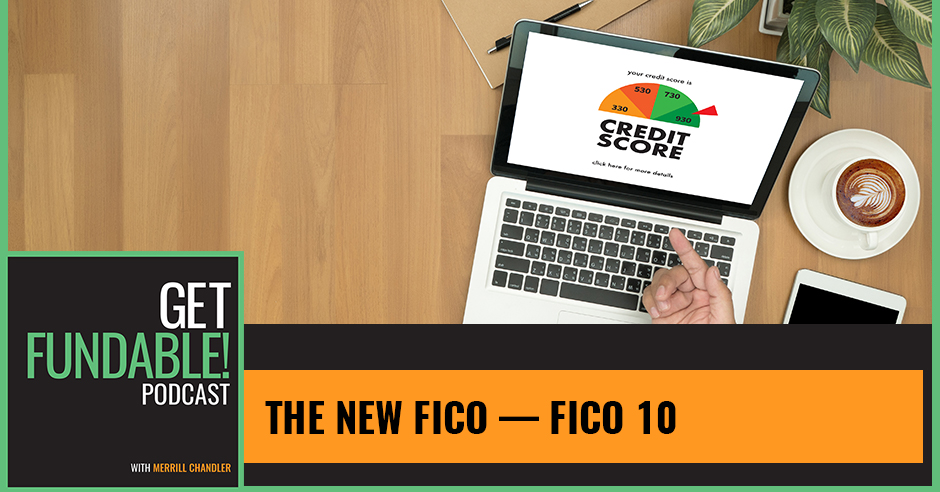
With the new FICO 10 just around the corner, Merrill Chandler uses this episode as a refresher…going into the history of FICO to enumerate all of the changes that have been implemented over the years. His bootcamp will dive deep into the new world of FICO 10 to give you every tool you’ll need. These changes are worth taking note of, especially if you are trying to increase your fundability™. Below, he will discuss in detail how FICO will be tracking your account management, its impact on your fundability™, and how to use all of this to your advantage. Learning about how FICO can be predictable and what it means for you as an individual is more than essential in the realm of funding!
—
Watch the episode here
Listen to the podcast here
The New FICO — FICO 10
When the People Who Said You Were “Crazy” Find Out You Were Right
FICO 10 is finally here…and I am beyond excited! This is the newest version of the FICO funding approval software, and all of the things that come with it. We’re going to take a deep dive into this awesome new world that includes some amazing news for all of us. For those of you who have been binging all of my episodes, you’re going to pick up on the things that I’ve been telling you—way ahead of their time!
—
I’m telling you right now…this is going to be such a fun conversation, because FICO 10 is absolutely killing it! In this article, we are going to be talking about how FICO 10 impacts you in every way. As I was completely my research for this topic, I have a thorough conversation with my FICO liaison, during which he brought up countless things that I have already been preparing you for—whether it was in my Bootcamp or my book. These important factors have all been forecasted to show themselves in this new FICO software, since they are tightening things up in a lot of different areas. I’ll warn you now…my credit-geek-side may show a lot…but that’s only because I’m so ecstatic about teaching this awesome subject matter to you!
Only the truth is actionable #GetFundable Click To TweetThe FICO Evolution
Before we get into the mind-blowing new aspects…I feel as though it’s important that we go through the history of FICO and the original score, along with everything that they have released over time. I call this the “FICO Score evolution!” The FICO Score originated back in 1989 as part of the credit evaluation for lenders. Although they have been evaluating our borrower behaviors since the 1950s, they later fine-tuned it in the late 1980s with a formal, tested score. When FICO 542 was announced in 1991, each and every credit bureau had their own, customized version of the FICO software: version 5 used by Equifax, 4 used by TransUnion, and 2 used by Experian (hence the name ‘542’). Two years later in 1993, FICO came out with the industry-specific scores. Sometimes I refer to them as “vertical scores” because they are vertical markets…scores for auto loans, credit cards, bank card scores, and for mortgage and small business lending.
All four of the vertical markets listed above started that year. Then, in 1995, Fannie Mae and Freddie Mac began using the FICO scores as well to evaluate the residential mortgages. Each one of these industry-specific scores has an entire division at FICO—where they build up based on the specific data for those scores. In 2001, FICO finally launched myFICO.com which is where to go if you not only want the actual truth about your credit score, but also to obtain an official copy of your mortgage, auto, or bank card scores without having to go to a broker, a dealer, etc. If you would like to learn more about these specific scores, be sure to read my book and attend my Bootcamp. They are accessible at GetFundableBook.com and GetFundableBootcamp.com if you want to check them out! We intensively explore these different scores and the many ways in which you can use them in your journey towards fundability™.

1031 Exchanges: FICO 10 uses trended data, sometimes called time series data. That’s how you’ve managed your accounts over the previous 24 months.
Every credit score you have is evaluated based on these verticals at myFICO.com and their reports. I wouldn’t recommend anything else because—as I always tell you—only the truth is actionable! We want to make sure that we can make proper and deliberate choices, which is only possible if we know the facts. When myFICO was put on the table in 2001, it empowered everyone. It was able to give borrowers the tools they need to see how they’re doing. In 2004, they even started offering FICO scores in other countries. And later, in 2007, they stated that the 100-billionth FICO score was sold. Those are basic milestones to keep in mind when learning about the history of FICO as an organization. Two years after this is when things began to develop even more radically!
FICO 8 and 9
In 2009…FICO Score 8 was introduced. It is the unweighted score that is commonly used more than the other ones by lenders. Although it’s been over a decade, it’s still considered a big deal today because it is the highest installed base! FICO started using what’s called the Economic Impact Index to examine more thoroughly, including some of the data being used for the FSSI score. These two are not the same. On the other hand, the FSSI score stands for the FICO Score Stress Indicator. It is a new release that is still being worked on…and has an integral relationship with FICO 10.
It was in 2012 when FICO announced scores for the Spanish-speaking language market. And just one year later, ‘open access’ was implemented. Open access basically gives you the opportunity to have free access when you go to your credit card issuer or some of your insurance companies. The copy of your FICO score that they will request is in fact the open access. You will read about this and learn how it works in different areas…but if or when they use the FICO Score 8 to establish a credit limit increase or to review your file, it’s called an account review. After 2013, FICO granted access for you to use your score to evaluate how your credit card holder is doing, and let you tell them that score. Don’t get this confused with the score that evaluates your auto, mortgage, and bank card scores…or even your big-ticket purchases. Think of the unweighted FICO Score 8 as a review score.
Also in 2013, they started allowing banks and credit card issuers to give you the score that they already purchased! And again…if you would like to read my book or attend my bootcamp, both take deep dives into not only the cute little facts, but how it impacts your fundability™ and funding approvals as well. Knowing the rules of this intricate game will undoubtedly score you a home run! The next year, in 2014…FICO Score 9 was launched. It contained a fresh new aspect where they removed any paid or unpaid collection (including medical) so that it wasn’t counted against your score. This was absolutely historical! And now, we find ourselves in an even more significant position. This is because in 2020, they announced that FICO 10 would be released. I want us to take a good look at where this new software is going to lead us…especially now that we have the various historical milestones under our belt!
Learn how FICO scores impact your fundability™. Knowing the rules of this game is a home run #GetFunable Click To TweetFICO 10 Changes
So what exactly is FICO Score 10? Thankfully, I have received the release paperwork from my FICO liaison about some of the big deals! As we discuss, I will be quoting the actual product sheet of FICO 10 to give you an outline. The first one that we need to talk about is FICO Score 10 Suite. This option will provide you with the unweighted score that lenders can provide you, as well as access to the auto, mortgage, bank card, and auxiliary business credit scores. Those are the features of FICO Score 10 Suite.
The next one is FICO 10 T, which considers your trended data. I don’t know why this stuff is so exciting to me…but it is! This second option says that lenders who use FICO 10 are going to have a significant reduction in a default. To quote it exactly, “A lender could reduce the number of defaults in their portfolio by as much as 10% among bank cards.” This means that with the predictive power of FICO 10, lenders will lose 10% less to default from this process. As a result, lenders will save 17% more from losses due to defaulting mortgages. Not only that, but 9% on auto loans, 10% on bank cards, and 17% on mortgages.
Those numbers are incredible…and come from just one version improvement from FICO! Now, let’s go over some of the big pieces of what this means! FICO 10 included the topic of trended data for the first time. I have built the entirety of my fundability™ optimization on trended data. We call it the ’24-month look-back period.’ Although FICO doesn’t use those exact words…you’ll notice that FICO 10 uses trended data sometimes, which is called ‘time-series data. This is basically how you’ve managed your accounts over the previous 24 months, which is exactly how I coach you guys (on my podcast, in my book, and at my Bootcamp) to become more and more fundable. This way, you can take down more funding approvals!
They’re distinguishing between two groups. The first is the transactors—borrowers who charge up to $10,000 on your credit card and then pay it to zero on the due date. On the other hand, the second group is the revolvers—individuals who carry a balance and then make a smaller or minimum payment on said balance. Nonetheless…in my experience, they don’t score those things. Instead, it is always based on the balance. Again, they are differentiating these two groups of people, but unfortunately they’re still not revealing to the world about the reporting date and how to carry the perfect balances at that time.
Consumers who pay their credit cards in full are considered lower risk than those who carry a balance. Over the 24-month look-back period, they’re watching the reduction, maintaining, or increasing of your balances. To add on to that—the score is watching all movement over this period. From the research we have done, and from the answers that some of the people at FICO have given us, the sections of this 24-month period is 3, 6, 12, and 24 months. The shocking part about all of this is the fact that they told this to us in private! They have never announced this information publicly. The ways in which you reduce, maintain, or increase your balances is being measured constantly. Even though I have been coaching you all on this, they’re going to come out in full force to tell everyone what they are up to. This is awesome for our borrower education efforts!

1031 Exchanges: Consumers who pay their credit cards in full are considered lower risk than those who carry a balance.
The next factor I would like to bring up is delinquencies. Under FICO 10, delinquencies will hurt your score even more! If you didn’t know, these are the 30, 60, and 90-day lates…which will impact you much more negatively than they did under the previous software versions: FICO 8, FICO 9, and FICO 542. Any delinquency in the slightest will work to destroy both your score and fundability™…and that destruction will last a long time! After 24 months, you will get back some of your credit score points from the delinquency. And after 48 months, even more. But that is still a long time to suffer!
Credit card debt will have a more drastic impact under FICO 10 as well. We’ve always talked about how your personal credit profile (or borrower profile) is the “goose that lays the golden eggs.” This means…the better you take care of your personal profile, the more funding opportunities you will have. And over on the business side, you have a higher capability of getting funding approvals. They’re tracking to a more significant degree the credit card debt, what the pace is, and what it is you’re carrying. All of this reveals the fact that credit card and personal loans may lower your score.
Remember…we call it ‘debt shifting,’ which I have been loud and proud about! Thankfully, we are some of the only people that now have the inside scoop on the impact all of this has. Lot’s of people who are in credit card debt will have the first instinct to go out and get a personal loan—whether it’s from a credit union, a financial technology company, etc. Usually, those personal loans have a lower interest than 18%, 22%, or 26% that a credit card would. But the problem here is that they’re always tracking! If you get a personal loan, pay down those credit cards, and then charge on those credit cards while carrying a balance…your score is going to take a significant hit!
There are strategies on how to use your revolving accounts and credit cards after you pay them down, but you still have to know the rules! They are only giving us the tiny, little tip of the iceberg. Think of the Titanic…FICO won’t talk about the stuff that would sink us, just how the iceberg wasn’t visible to the Titanic’s crew before impact. Personal loans are used to pay down credit, but if you don’t use your credit cards in the correct way afterwards, your score will plummet significantly. Every little movement in your profile is going to have a greater impact. In my Bootcamp…we talk about what we call the Fundability™ Pyramid, which explains how if you do an activity, the impact of that activity will be different based on where you currently are on the credit profile.
Any delinquency has an immediate impact against your score and your fundability™, and it's going to last #GetFundable Click To TweetLet’s say that you get an inquiry. If your scores are in the 600’s, that inquiry may take around fifteen points. In the 700’s, that may only count ten points against you. And if you’re up in the 800 area, they may only count five points against you. Wherever you are on the fundability™ pyramid is how much of a hit you take! It works the same way with gaining points as well. If you do a positive borrower behavior, it has less impact. FICO 10 even says that those movements are going to be even bigger soon! For example, if you have a $10,000 credit card and you pay down $5,000 (half of it, with 50% utilization), you charge all the way up and get paid half of it back.
They key word here is ‘impact’ which will be much more dangerous than it was in FICO 9, 8, and 542. Negative behaviors—including inquiries, late pays, and high balances—will strike you down more than ever before. This relates back to the saying, “The bad gets worse.” FICO 10 is phenomenal…and apparently, lenders can opt for either FICO 10 or FICO 10 T, which means all of the trending data are the bombs!
To give you a quick recap: FICO 10 is going to be soon available to lenders, with an entire suite of scores. In able to get more of the inside scoop, purchase my book: The New F* Word at GetFundableBook.com. Once it is published, there will be an entire section on FICO 10 and how it works! And at my Bootcamp…within just two days, you will learn about what actually matters across the 40 borrower behaviors thoroughly. Come and find out how to use all 40 of them to your highest advantage!

1031 Exchanges: The more predictive FICO gets, the more power we have over our funding approvals.
Throughout history, FICO has continued to grow tighter and tighter. The more predictive they get, the more power we have over our funding approvals! If we know what they’re measuring and what they’re looking for within their funding guidelines…all we have to do is behave in order to fit the funding guidelines. All of these factors will result in you being in charge of your approvals! It’s always a positive sign when these things become more predictive, and I love that we know exactly what those borrower behaviors are and how to add them to your skillset to use them appropriately. With the craziness of today’s world (which included a raging pandemic, the new insanity of these markets, and the coming recession that everyone is talking about), it is finally time to educate yourself on the rules of the funding game so that you can survive as a business or even as a family! We are truly in a state of funding survival.
From there, we can show you how to protect your business and create what we call the “slingshot effect” in order to not only thrive, but launch yourself into the next phase as well. Thank you for joining me to read this essential, educational information. Join us to be apart of this welcoming community so you can prepare for exactly how FICO will truly transform your life and show you how to get funded!
Important Links:
Love the show? Subscribe, rate, review, and share!




